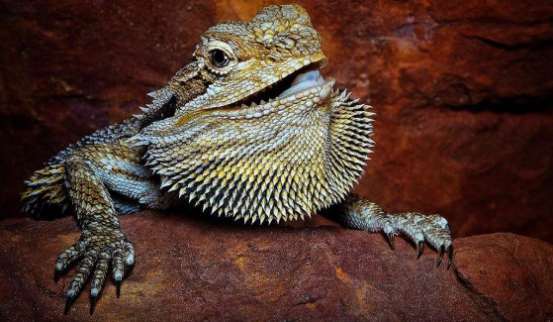To help you understand your bearded dragons better, here are a few FAQs and fun facts we have compiled for you.

Bearded Dragon FAQs
Except for the Eastern bearded dragon that has two primitive venom glands, the rest of the species, including Pogona vitticeps, have only one. When they bite, they release a mild venom that can kill small insects but not humans.
While they don’t bite humans, if it occurs accidentally, such as when you are handing them, or if they scratch you, disinfect and clean the area since they do carry parasites and harmful germs including bacteria like salmonella.
Also, ensure you wash your hands with a hand sanitizer or soapy water before and after touching this pet or their habitat.
No. Although these spiny scales may appear dangerous like those of a porcupine, they are not sharp and will not harm you even when they flare their chin.
Depending on their nature and the nature of other pets, you can keep them and have dogs, cats, and so on. However, never leave them unsupervised even after they have bonded well.
UVA helps in stimulating activities like feeding and breeding as well as in boosting their overall health, i.e., UVA helps regulate their daily and seasonal activity.
On the other hand, UVB helps their skin in synthesis vitamin D3 needed for calcium absorption.
Fun or fascinating facts
- They are solitary animals that prefer or love being left alone except during mating time. Don’t worry about them being lonely. Also, avoid housing them together as they will begin competing for various resources with the dominant once taking advantage.
- While they don’t make any other vocalizations, they do hiss when threatened by a predator or startled.
- They are good runners. These lizards can run at speeds of 14.5km/h while pursuing their prey (food), escaping from predators, and so on. When running fast, they rise and run in the same way bipeds do since they cannot keep on their four as their center of gravity shifts towards their rear.
- Since they live in deserts and semi-arid environments, they don’t urinate as we do. Instead, they excrete dry urine to minimize water loss. Usually, the chalky stuff that comes out with poop is urine.
- They have funny sleeping postures. Sometimes, they can sleep in a vertical orientation, i.e., standing on their hind legs with their knees locked.
- When they hatch, a bearded dragon hatchling weighs about 2 grams and measures about 4 cm.
- They don’t like surprises, especially if you approach or try to pick from above or if they have not seen you coming.
- They have excellent sight and can see objects that are far away so well as well as more colors than human beings. Furthermore, they can see some light rays beyond human visual limits.
- Their front teeth regrow if the fall, but their side teeth don’t grow back should they fall. Similarly, their tails don’t grow back if nipped, and they don’t drop their tails like lizards when attacked by predators.
- They change their color as a means of communication, when under darkness or light, as well as when basking (want to absorb more or less heat).
- Their sturdy spines around their head, chin, and neck work as a protective armor when they are under attack, a reason why they puff them.
- While in the wild, their colors have a striking resemblance from the soil where they live. However, this is not the same as those bred selectively, i.e., the morphs.
- They drink rainwater bowing or sloping their bodies forward to allow and allowing water trapped in their bumps and spines to run down to their snout.
- Their smelling and tasking organs are on the roof of their mouth. They pick scents and test by licking things or sticking their tongue out.
- They have a parietal or third eye on the top part of their head. While it doesn’t process images, it does have light and dark sensing cells that help it know the time or detect an aerially approaching predator.
